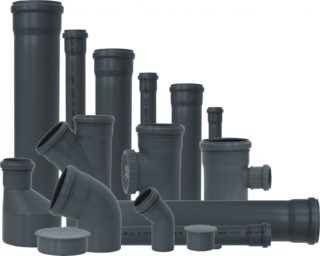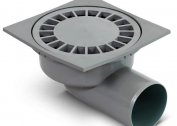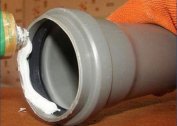The layout of the sewer in the apartment has its own characteristics. Housing owners in new buildings often face the problem of installing plumbing. Sometimes the outlet point to the riser is too high from the floor, so you have to raise the shower stalls to provide the desired slope. The reliability of the drainage system depends on compliance with SNiP during installation and selection of materials.
How is the sewage system in an apartment building
Disposal of sewage contaminated with household waste is arranged by gravity, so it is important to observe the angle of the pipes provided for connecting each plumbing fixture. The sewer riser, on the one hand, has an outlet to the atmosphere, and on the other hand, an outlet to the inspection well. Sinks, bathtubs, showers are connected to the sewage system through siphons, which prevent the penetration of gases into residential premises. The design of the toilets and bidets include built-in water locks.
Volley drains when using toilets create a vacuum that is balanced by atmospheric air entering the riser through the outlet on the roof. Without this device, the low pressure zone would facilitate the suction of water from the siphons, freeing up the path for the accumulated gases to escape.
Required Pipe Slope
 When mounting with a large slope, the flow rate of contaminated water increases, which leads to its rapid discharge. Sewer pipes are silted with household waste (ZhBO), which cannot be transported in pipelines without liquid. For this reason, the maximum slope of 150 mm / m is regulated.
When mounting with a large slope, the flow rate of contaminated water increases, which leads to its rapid discharge. Sewer pipes are silted with household waste (ZhBO), which cannot be transported in pipelines without liquid. For this reason, the maximum slope of 150 mm / m is regulated.
The SNiP rules provide for the following norms of slopes per linear meter for pipes of different sizes:
- D200 mm - 7 mm / m;
- D160 mm - 8 mm / m;
- D110 mm - 20 mm / m;
- D50 mm - 30 mm / m.
It is not recommended to lay out horizontally, as this will lead to a halt in the self-cleaning function, which will not allow the waste to go towards the sewer well. Likely consequences: basement flooding, siltation of the pipeline, disruption of the siphon system.
Planning and conducting necessary calculations
 To sewer in an apartment, you need to determine the front of work and the cost of repair. At the first stage, an arrangement of the plumbing devices is made. When redeveloping bathrooms, you can add new appliances or move existing ones.
To sewer in an apartment, you need to determine the front of work and the cost of repair. At the first stage, an arrangement of the plumbing devices is made. When redeveloping bathrooms, you can add new appliances or move existing ones.
The sewerage diagram must indicate:
- rooms of bathrooms and kitchens;
- location of risers;
- the distance to the walls when connecting plumbing;
- fittings and revisions;
- bends for cleaning.
The length of the sections, the diameter of the pipes and the angle of inclination are indicated. After that, calculations are performed, which include:
- the number of pipes of different diameters;
- connecting and adapter couplings;
- adapters from plastic to cast iron;
- sealant;
- additional fittings for turns and branches;
- other consumables: rubber cuffs, gaskets, crutches, etc.
Cuttings should be used as little as possible, since each connection will require the presence of couplings, which reduces reliability, aesthetics and leads to higher cost of work.
Diameters are selected depending on the installation location: for a riser, d 110 mm, d160 mm and d200 mm are used. The wiring in the apartment is made of pipes d40 mm and d50 mm. To connect to the drainage system of dishwashers and washing machines, d32 mm is used.
Material selection
Polymer products have obvious advantages over iron casting: less weight, a wide variety of fittings to perform any configuration scheme, corrosion resistance and a long service life when working in the selected temperature range.
Polyethylene
The material is cheap, but easily deformed when exposed to high temperatures, as it has low heat resistance. A pipeline mounted from it allows leakage. Polyethylene products are not recommended for the installation of a sewer system due to the low technical quality of the material.
Polypropylene
It has high strength, so it allows you to remove blockages using plumbing cables. Resistant to high temperatures (up to 130 degrees) and to solutions of chemically active substances. Products have high hydraulic resistance due to the rough inner surface, therefore it is recommended in pipelines with a large diameter.
Polyvinyl chloride
The best choice for laying your own sewer. Its advantages are low cost, strength and durability. The temperature of the effluent is allowed up to 80 degrees. Compared with polypropylene, it has better hydrodynamic characteristics, but has lower chemical resistance.
Removing the old system
To disassemble the sewer riser, daytime is chosen when most of the neighbors are at work. It is recommended to work in a helmet. It is important to carry out preliminary activities:
- turn off the supply of hot and cold water in the basement;
- cover the floor and walls with a protective film, you can use adhesive tape to connect the joints;
- prepare a raincoat and rubber boots in case of an emergency.
Dismantling the plastic system is not complicated, it consists in unscrewing old pipes.
Alteration of cast iron wiring will require a lot of effort, since the joints are connected by the method of caulking with asbestos or linen cords and cementitious mortar. If necessary, act with a grinder: saw a hole; they insert a wedge and, striking it, they break apart the cast-iron product into pieces.
First, disconnect the pipe from the riser using 2 cuts. The remaining tap into the riser is hammered in to remove residual fragments. The hole is plugged with rags. Then they begin dismantling from the end of the wiring, from plumbing fixtures. At the last stage, the riser is cut and work begins on its replacement.
Stages of installation of the sewer system
 After acquiring materials, before dismantling, it is recommended to assemble the piping for fitting. Only after making sure that the necessary components and parts are available, they begin to dismantle the old pipes.
After acquiring materials, before dismantling, it is recommended to assemble the piping for fitting. Only after making sure that the necessary components and parts are available, they begin to dismantle the old pipes.
Collect the sewer according to the scheme, sealing the joints of the elements, then connect the plumbing. At the last stage, the output is mounted in the sewer riser. Check for leaks after some time required for the sealant to harden. It is applied to the inside of the connecting pipe and the outer portion of the pipe inserted into it.
Common mistakes
Failure to comply with the rules for installing sewage in the apartment leads to emergency situations.
- A large number of horizontal branches made at right angles without observing the angle of inclination. It is advised to rotate at an angle no less than 130 degrees. This avoids the occurrence of garbage jams and extends the life of the sewer.
- Failure to comply with bias. If the semi-basement low room does not allow for proper installation, install pumping pumps that provide forced withdrawal of sewage. In this case, waste shredders are needed, which increase the cost of the system.
- The combination of wastewater from sinks and toilets leads to the deposition of fat on the surface of the pipes, which contributes to the rapid formation of blockages.
- Incorrect calculation of the performance of the sewer system. Sewerage of an apartment equipped with an office with a large number of employees may not be designed to increase the volume of drains, which leads to flooding of the underlying floors.
- When sealing joints, you need to focus on reliability, and not on aesthetics.
In private homes, an emergency can be caused by a shallow laying of the pipeline, which does not take into account the depth of freezing of the soil.





